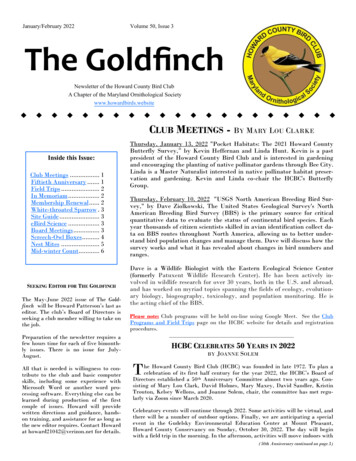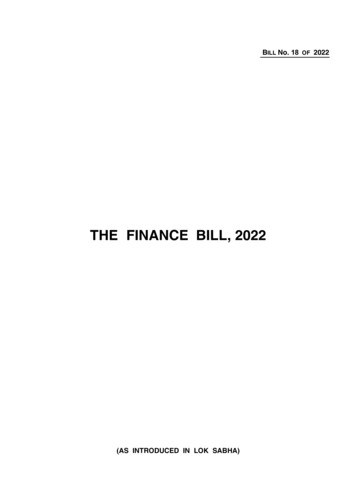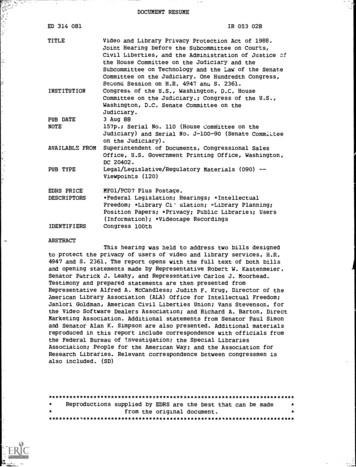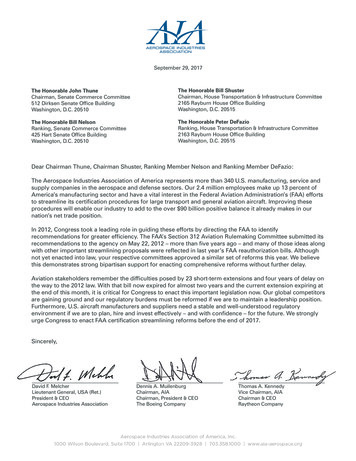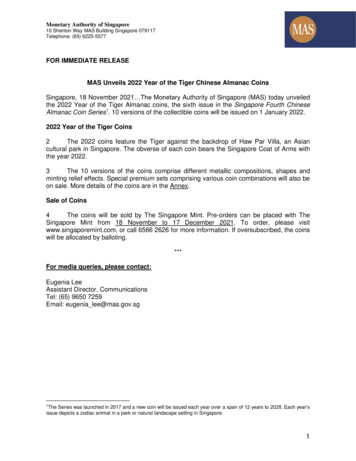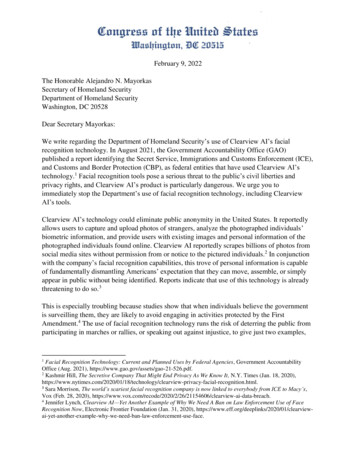
Transcription
February 9, 2022The Honorable Alejandro N. MayorkasSecretary of Homeland SecurityDepartment of Homeland SecurityWashington, DC 20528Dear Secretary Mayorkas:We write regarding the Department of Homeland Security’s use of Clearview AI’s facialrecognition technology. In August 2021, the Government Accountability Office (GAO)published a report identifying the Secret Service, Immigrations and Customs Enforcement (ICE),and Customs and Border Protection (CBP), as federal entities that have used Clearview AI’stechnology.1 Facial recognition tools pose a serious threat to the public’s civil liberties andprivacy rights, and Clearview AI’s product is particularly dangerous. We urge you toimmediately stop the Department’s use of facial recognition technology, including ClearviewAI’s tools.Clearview AI’s technology could eliminate public anonymity in the United States. It reportedlyallows users to capture and upload photos of strangers, analyze the photographed individuals’biometric information, and provide users with existing images and personal information of thephotographed individuals found online. Clearview AI reportedly scrapes billions of photos fromsocial media sites without permission from or notice to the pictured individuals.2 In conjunctionwith the company’s facial recognition capabilities, this trove of personal information is capableof fundamentally dismantling Americans’ expectation that they can move, assemble, or simplyappear in public without being identified. Reports indicate that use of this technology is alreadythreatening to do so.3This is especially troubling because studies show that when individuals believe the governmentis surveilling them, they are likely to avoid engaging in activities protected by the FirstAmendment.4 The use of facial recognition technology runs the risk of deterring the public fromparticipating in marches or rallies, or speaking out against injustice, to give just two examples,1Facial Recognition Technology: Current and Planned Uses by Federal Agencies, Government AccountabilityOffice (Aug. 2021), https://www.gao.gov/assets/gao-21-526.pdf.2Kashmir Hill, The Secretive Company That Might End Privacy As We Know It, N.Y. Times (Jan. 18, y/clearview-privacy-facial-recognition.html.3Sara Morrison, The world’s scariest facial recognition company is now linked to everybody from ICE to Macy’s,Vox (Feb. 28, 2020), rview-ai-data-breach.4Jennifer Lynch, Clearview AI—Yet Another Example of Why We Need A Ban on Law Enforcement Use of FaceRecognition Now, Electronic Frontier Foundation (Jan. 31, 2020), t-use-face.
The Honorable Alejandro N. MayorkasFebruary 9, 2022Page 2for fear of being permanently included in law enforcement databases. In short, this technologyutilizes a high level of surveillance that is often inconsistent with Americans’ right to privacy.Additionally, this technology poses unique threats to Black communities, other communities ofcolor, and immigrant communities. An analysis of facial recognition tools conducted by theNational Institute of Standards and Technology (NIST) found that Black, Brown, and Asianindividuals were up to 100 times more likely to be misidentified than white male faces.5Consistent with this research, at least three Black men have already been wrongfullyarrested based on a false facial recognition match.6Facial recognition technology like Clearview’s poses unique threats to marginalizedcommunities in ways that extend beyond the tools’ inaccuracy issues. Communities of color aresystematically subjected to over-policing,7 and the proliferation of biometric surveillance toolsis, therefore, likely to disproportionately infringe upon the privacy of individuals in Black,Brown, and immigrant communities. With respect to law enforcement use of biometrictechnologies specifically, reports suggest that use of the technology has been promoted amonglaw enforcement professionals, 8 and reviews of deployment of facial recognition technologyshow that law enforcement entities are more likely to use it on Black and Brown individuals thanthey are on white individuals.9 Additionally, past law enforcement use of this technologyreportedly targeted Black Lives Matter activists.10Use of increasingly powerful technologies like Clearview AI’s have the concerning potential toviolate Americans’ privacy rights and exacerbate existing injustices. Therefore, as the authors ofthe Facial Recognition and Biometric Technology Moratorium Act (S. 2052/H.R. 3907) —which would halt a federal agency or official from using these technologies11 — we urge you tostop use of facial recognition tools, including Clearview AI’s products.5National Institute of Standards and Technology, NIST Study Evaluates Effects of Race, Age, Sex on FaceRecognition Software (Dec. 19, 2019), ion-software6Kashmir Hill, Another Arrest, and Jail Time, Due to a Bad Facial Recognition Match, N.Y. Times (Dec. 29,2020), al-recognition-misidentify-jail.html.7Elizabeth Hinton, LeShae Henderson, & Cindy Reed, An Unjust Burden: The DisparateTreatment of Black Americans in the Criminal Justice System, Vera Institute for Justice (May f; Criminal JusticeFact Sheet, The National Association for the Advancement of Colored People, heet.8Carole Haskins, A Popular Workshop for Police Encouraged Cops to Use Face Scans to ID People they Pull Overat Traffic Stops, Business Insider (Feb. 2, 2022), c-stops-2022-2?op 1.9Automated Regional Justice Information System, San Diego’s Privacy Policy Development: Efforts & LessonsLearned, /2021/04/E5-Meaningful-Metrics-1-1.pdf.10James Vincent, NYPD Used Facial Recognition to Track Down Black Lives Matter Activist, The Verge (Aug. 18,2020), ickingram/.11Facial Recognition and Biometric Technology Moratorium Act, S. 2052, 117 th Congress § 1 (2021); FacialRecognition and Biometric Technology Moratorium Act, H.R. 3907, 117 th Congress § 1 (2021).
The Honorable Alejandro N. MayorkasFebruary 9, 2022Page 3Thank you for your attention to this important matter.Sincerely,Edward J. MarkeyUnited States SenatorPramila JayapalUnited States RepresentativeJeffrey A. MerkleyUnited States SenatorAyanna PressleyUnited States Representativecc: The Honorable James M. Murray, Director, U.S. Secret ServiceThe Honorable Tae Johnson, Director, U.S. Immigration and Customs EnforcementThe Honorable Chris Magnus, Commissioner, U.S. Customs and Border Protection
February 9, 2022The Honorable Merrick B. GarlandU.S. Attorney GeneralDepartment of JusticeWashington, DC 20530Dear Attorney General Garland:We write regarding the Department’s use of Clearview AI’s facial recognition technology. InAugust 2021, the Government Accountability Office (GAO) published a report identifying theBureau of Alcohol, Tobacco, Firearms and Explosives, the Drug Enforcement Administration(DEA), the Federal Bureau of Investigation (FBI), and the U.S. Marshals Service, as federalentities that have used Clearview AI’s technology.1 Facial recognition tools pose a serious threatto the public’s civil liberties and privacy rights, and Clearview AI’s product is particularlydangerous. We urge you to immediately stop the Department’s use of facial recognitiontechnology, including Clearview AI’s tools.Clearview AI’s technology could eliminate public anonymity in the United States. It reportedlyallows users to capture and upload photos of strangers, analyze the photographed individuals’biometric information, and provide users with existing images and personal information of thephotographed individuals found online. Clearview AI reportedly scrapes billions of photos fromsocial media sites without permission from or notice to the pictured individuals.2 In conjunctionwith the company’s facial recognition capabilities, this trove of personal information is capableof fundamentally dismantling Americans’ expectation that they can move, assemble, or simplyappear in public without being identified. Reports indicate that use of this technology is alreadythreatening to do so.3This is especially troubling because studies show that when individuals believe the governmentis surveilling them, they are likely to avoid engaging in activities protected by the FirstAmendment.4 The use of facial recognition technology runs the risk of deterring the public fromparticipating in marches or rallies, or speaking out against injustice, to give just two examples,for fear of being permanently included in law enforcement databases. In short, this technologyutilizes a high level of surveillance that is often inconsistent with Americans’ right to privacy.1Facial Recognition Technology: Current and Planned Uses by Federal Agencies, Government AccountabilityOffice (Aug. 2021), https://www.gao.gov/assets/gao-21-526.pdf.2Kashmir Hill, The Secretive Company That Might End Privacy As We Know It, N.Y. Times (Jan. 18, y/clearview-privacy-facial-recognition.html.3Sara Morrison, The world’s scariest facial recognition company is now linked to everybody from ICE to Macy’s,Vox (Feb. 28, 2020), rview-ai-data-breach.4Jennifer Lynch, Clearview AI—Yet Another Example of Why We Need A Ban on Law Enforcement Use of FaceRecognition Now, Electronic Frontier Foundation (Jan. 31, 2020), t-use-face.
The Honorable Merrick B. GarlandFebruary 9, 2022Page 2Additionally, this technology poses unique threats to Black communities, other communities ofcolor, and immigrant communities. An analysis of facial recognition tools conducted by theNational Institute of Standards and Technology (NIST) found that Black, Brown, and Asianindividuals were up to 100 times more likely to be misidentified than white male faces.5Consistent with this research, at least three Black men have already been wrongfullyarrested based on a false facial recognition match.6Facial recognition technology like Clearview’s poses unique threats to marginalizedcommunities in ways that extend beyond the tools’ inaccuracy issues. Communities of color aresystematically subjected to over-policing,7 and the proliferation of biometric surveillance toolsis, therefore, likely to disproportionately infringe upon the privacy of individuals in Black,Brown, and immigrant communities. With respect to law enforcement use of biometrictechnologies specifically, reports suggest that use of the technology has been promoted amonglaw enforcement professionals, 8 and reviews of deployment of facial recognition technologyshow that law enforcement entities are more likely to use it on Black and Brown individuals thanthey are on white individuals.9 Additionally, past law enforcement use of this technologyreportedly targeted Black Lives Matter activists.10Use of increasingly powerful technologies like Clearview AI’s have the concerning potential toviolate Americans’ privacy rights and exacerbate existing injustices. Therefore, as the authors ofthe Facial Recognition and Biometric Technology Moratorium Act (S. 2052/H.R. 3907) —which would halt a federal agency or official from using these technologies11 — we urge you tostop use of facial recognition tools, including Clearview AI’s products.Thank you for your attention to this important matter.5National Institute of Standards and Technology, NIST Study Evaluates Effects of Race, Age, Sex on FaceRecognition Software (Dec. 19, 2019), ion-software6Kashmir Hill, Another Arrest, and Jail Time, Due to a Bad Facial Recognition Match, N.Y. Times (Dec. 29,2020), al-recognition-misidentify-jail.html.7Elizabeth Hinton, LeShae Henderson, & Cindy Reed, An Unjust Burden: The DisparateTreatment of Black Americans in the Criminal Justice System, Vera Institute for Justice (May f; Criminal JusticeFact Sheet, The National Association for the Advancement of Colored People, heet.8Carole Haskins, A Popular Workshop for Police Encouraged Cops to Use Face Scans to ID People they Pull Overat Traffic Stops, Business Insider (Feb. 2, 2022), c-stops-2022-2?op 1.9Automated Regional Justice Information System, San Diego’s Privacy Policy Development: Efforts & LessonsLearned, /2021/04/E5-Meaningful-Metrics-1-1.pdf.10James Vincent, NYPD Used Facial Recognition to Track Down Black Lives Matter Activist, The Verge (Aug. 18,2020), ickingram/.11Facial Recognition and Biometric Technology Moratorium Act, S. 2052, 117th Congress § 1 (2021); FacialRecognition and Biometric Technology Moratorium Act, H.R. 3907, 117 th Congress § 1 (2021).
The Honorable Merrick B. GarlandFebruary 9, 2022Page 3Sincerely,Edward J. MarkeyUnited States SenatorPramila JayapalUnited States RepresentativeJeffrey A. MerkleyUnited States SenatorAyanna PressleyUnited States Representativecc: The Honorable Marvin Richardson, Acting Director, U.S. Bureau of Alcohol,Tobacco, Firearms and ExplosivesThe Honorable Anne Milgram, Administrator, U.S. Drug Enforcement AdministrationThe Honorable Christopher A. Wray, Director, Federal Bureau of InvestigationThe Honorable Ronald L. Davis, Director, U.S. Marshals Service
February 9, 2022The Honorable Lloyd J. Austin IIISecretary of DefenseU.S. Department of Defense1000 Defense PentagonWashington, D.C. 20301Dear Secretary Austin:We write regarding the Department of Defense’s use of Clearview AI’s facial recognitiontechnology. In August 2021, the Government Accountability Office (GAO) published a reportidentifying the U.S. Air Force, as a federal entity that has used Clearview AI’s technology. 1Facial recognition tools pose a serious threat to the public’s civil liberties and privacy rights, andClearview AI’s product is particularly dangerous. We urge you to immediately stop theDepartment’s use of facial recognition technology, including Clearview AI’s tools.Clearview AI’s technology could eliminate public anonymity in the United States. It reportedlyallows users to capture and upload photos of strangers, analyze the photographed individuals’biometric information, and provide users with existing images and personal information of thephotographed individuals found online. Clearview AI reportedly scrapes billions of photos fromsocial media sites without permission from or notice to the pictured individuals. 2 In conjunctionwith the company’s facial recognition capabilities, this trove of personal information is capableof fundamentally dismantling Americans’ expectation that they can move, assemble, or simplyappear in public without being identified. Reports indicate that use of this technology is alreadythreatening to do so. 3This is especially troubling because studies show that when individuals believe the governmentis surveilling them, they are likely to avoid engaging in activities protected by the FirstAmendment. 4 The use of facial recognition technology runs the risk of deterring the public fromparticipating in marches or rallies, or speaking out against injustice, to give just two examples,for fear of being permanently included in law enforcement databases. In short, this technologyutilizes a high level of surveillance that is often inconsistent with Americans’ right to privacy.Facial Recognition Technology: Current and Planned Uses by Federal Agencies, Government AccountabilityOffice (Aug. 2021), https://www.gao.gov/assets/gao-21-526.pdf.2Kashmir Hill, The Secretive Company That Might End Privacy As We Know It, N.Y. Times (Jan. 18, y/clearview-privacy-facial-recognition.html.3Sara Morrison, The world’s scariest facial recognition company is now linked to everybody from ICE to Macy’s,Vox (Feb. 28, 2020), rview-ai-data-breach.4Jennifer Lynch, Clearview AI—Yet Another Example of Why We Need A Ban on Law Enforcement Use of FaceRecognition Now, Electronic Frontier Foundation (Jan. 31, 2020), t-use-face.1
The Honorable Lloyd J. Austin IIIFebruary 9, 2022Page 2Additionally, this technology poses unique threats to Black communities, other communities ofcolor, and immigrant communities. An analysis of facial recognition tools conducted by theNational Institute of Standards and Technology (NIST) found that Black, Brown, and Asianindividuals were up to 100 times more likely to be misidentified than white male faces. 5Consistent with this research, at least three Black men have already been wrongfullyarrested based on a false facial recognition match. 6Facial recognition technology like Clearview’s poses unique threats to marginalizedcommunities in ways that extend beyond the tools’ inaccuracy issues. Communities of color aresystematically subjected to over-policing, 7 and the proliferation of biometric surveillance toolsis, therefore, likely to disproportionately infringe upon the privacy of individuals in Black,Brown, and immigrant communities. With respect to law enforcement use of biometrictechnologies specifically, reports suggest that use of the technology has been promoted amonglaw enforcement professionals, 8 and reviews of deployment of facial recognition technologyshow that law enforcement entities are more likely to use it on Black and Brown individuals thanthey are on white individuals. 9 Additionally, past law enforcement use of this technologyreportedly targeted Black Lives Matter activists. 10Use of increasingly powerful technologies like Clearview AI’s have the concerning potential toviolate Americans’ privacy rights and exacerbate existing injustices. Therefore, as the authors ofthe Facial Recognition and Biometric Technology Moratorium Act (S. 2052/H.R. 3907) —which would halt a federal agency or official from using these technologies 11 — we urge you tostop use of facial recognition tools, including Clearview AI’s products.Thank you for your attention to this important matter.National Institute of Standards and Technology, NIST Study Evaluates Effects of Race, Age, Sex on FaceRecognition Software(Dec. 19, 2019), ion-software6Kashmir Hill, Another Arrest, and Jail Time, Due to a Bad Facial Recognition Match, N.Y, Times (Dec. 29,2020), al-recognition-misidentify-jail.html.7Elizabeth Hinton, LeShae Henderson, & Cindy Reed, An Unjust Burden: The DisparateTreatment of Black Americans in the Criminal Justice System, Vera Institute for Justice (May f; Criminal JusticeFact Sheet, The National Association for the Advancement of Colored People, heet.8Carole Haskins, A Popular Workshop for Police Encouraged Cops to Use Face Scans to ID People they Pull Overat Traffic Stops, Business Insider (Feb. 2, 2022), c-stops-2022-2?op 1.9Automated Regional Justice Information System, San Diego’s Privacy Policy Development: Efforts & LessonsLearned, /2021/04/E5-Meaningful-Metrics-1-1.pdf.10James Vincent, NYPD Used Facial Recognition to Track Down Black Lives Matter Activist, The Verge (Aug. 18,2020), ickingram/.11Facial Recognition and Biometric Technology Moratorium Act, S. 2052, 117th Congress § 1 (2021); FacialRecognition and Biometric Technology Moratorium Act, H.R. 3907, 117th Congress § 1 (2021).5
The Honorable Lloyd J. Austin IIIFebruary 9, 2022Page 3Sincerely,Edward J. MarkeyUnited States SenatorPramila JayapalUnited States RepresentativeJeffrey A. MerkleyUnited States SenatorAyanna PressleyUnited States Representativecc: The Honorable Frank Kendall, Secretary, U.S. Air Force
February 9, 2022The Honorable Xavier BecerraSecretaryDepartment of Health and Human Services200 Independence AvenueWashington, DC 20201Dear Secretary Becerra:We write regarding the Department of Health and Human Services’ use of Clearview AI’s facialrecognition technology. In August 2021, the Government Accountability Office (GAO)published a report identifying the Office of Inspector General for the United States Departmentof Health and Human Services, as a federal entity that has used Clearview AI’s technology. 1Facial recognition tools pose a serious threat to the public’s civil liberties and privacy rights, andClearview AI’s product is particularly dangerous. We urge you to immediately stop theDepartment’s use of facial recognition technology, including Clearview AI’s tools.Clearview AI’s technology could eliminate public anonymity in the United States. It reportedlyallows users to capture and upload photos of strangers, analyze the photographed individuals’biometric information, and provide users with existing images and personal information of thephotographed individuals found online. Clearview AI reportedly scrapes billions of photos fromsocial media sites without permission from or notice to the pictured individuals. 2 In conjunctionwith the company’s facial recognition capabilities, this trove of personal information is capableof fundamentally dismantling Americans’ expectation that they can move, assemble, or simplyappear in public without being identified. Reports indicate that use of this technology is alreadythreatening to do so. 3This is especially troubling because studies show that when individuals believe the governmentis surveilling them, they are likely to avoid engaging in activities protected by the FirstAmendment. 4 The use of facial recognition technology runs the risk of deterring the public fromparticipating in marches or rallies, or speaking out against injustice, to give just two examples,for fear of being permanently included in law enforcement databases. In short, this technologyutilizes a high level of surveillance that is often inconsistent with Americans’ right to privacy.Facial Recognition Technology: Current and Planned Uses by Federal Agencies, Government AccountabilityOffice (Aug. 2021), https://www.gao.gov/assets/gao-21-526.pdf.2Kashmir Hill, The Secretive Company That Might End Privacy As We Know It, N.Y. Times (Jan. 18, y/clearview-privacy-facial-recognition.html.3Sara Morrison, The world’s scariest facial recognition company is now linked to everybody from ICE to Macy’s,Vox (Feb. 28, 2020), rview-ai-data-breach.4Jennifer Lynch, Clearview AI—Yet Another Example of Why We Need A Ban on Law Enforcement Use of FaceRecognition Now, Electronic Frontier Foundation (Jan. 31, 2020), t-use-face.1
The Honorable Xavier BecerraFebruary 9, 2022Page 2Additionally, this technology poses unique threats to Black communities, other communities ofcolor, and immigrant communities. An analysis of facial recognition tools conducted by theNational Institute of Standards and Technology (NIST) found that Black, Brown, and Asianindividuals were up to 100 times more likely to be misidentified than white male faces. 5Consistent with this research, at least three Black men have already been wrongfullyarrested based on a false facial recognition match. 6Facial recognition technology like Clearview’s poses unique threats to marginalizedcommunities in ways that extend beyond the tools’ inaccuracy issues. Communities of color aresystematically subjected to over-policing, 7 and the proliferation of biometric surveillance toolsis, therefore, likely to disproportionately infringe upon the privacy of individuals in Black,Brown, and immigrant communities. With respect to law enforcement use of biometrictechnologies specifically, reports suggest that use of the technology has been promoted amonglaw enforcement professionals, 8 and reviews of deployment of facial recognition technologyshow that law enforcement entities are more likely to use it on Black and Brown individuals thanthey are on white individuals. 9 Additionally, past law enforcement use of this technologyreportedly targeted Black Lives Matter activists. 10Use of increasingly powerful technologies like Clearview AI’s have the concerning potential toviolate Americans’ privacy rights and exacerbate existing injustices. Therefore, as the authors ofthe Facial Recognition and Biometric Technology Moratorium Act (S. 2052/H.R. 3907) —which would halt a federal agency or official from using these technologies 11 — we urge you tostop use of facial recognition tools, including Clearview AI’s products.Thank you for your attention to this important matter.National Institute of Standards and Technology, NIST Study Evaluates Effects of Race, Age, Sex on FaceRecognition Software (Dec. 19, 2019), ion-software6Kashmir Hill, Another Arrest, and Jail Time, Due to a Bad Facial Recognition Match, N. Y. Times (Dec. 29,2020), al-recognition-misidentify-jail.html.7Elizabeth Hinton, LeShae Henderson, & Cindy Reed, An Unjust Burden: The DisparateTreatment of Black Americans in the Criminal Justice System, Vera Institute for Justice (May f; Criminal JusticeFact Sheet, The National Association for the Advancement of Colored People, heet.8Carole Haskins, A Popular Workshop for Police Encouraged Cops to Use Face Scans to ID People they Pull Overat Traffic Stops, Business Insider (Feb. 2, 2022), c-stops-2022-2?op 1.9Automated Regional Justice Information System, San Diego’s Privacy Policy Development: Efforts & LessonsLearned, /2021/04/E5-Meaningful-Metrics-1-1.pdf.10James Vincent, NYPD Used Facial Recognition to Track Down Black Lives Matter Activist, The Verge (Aug. 18,2020), ickingram/.11Facial Recognition and Biometric Technology Moratorium Act, S. 2052, 117th Congress § 1 (2021); FacialRecognition and Biometric Technology Moratorium Act, H.R. 3907, 117th Congress § 1 (2021).5
The Honorable Xavier BecerraFebruary 9, 2022Page 3Sincerely,Edward J. MarkeyUnited States SenatorPramila JayapalUnited States RepresentativeJeffrey A. MerkleyUnited States SenatorAyanna PressleyUnited States Representativecc: The Honorable Christi Grimm, Principal Deputy Inspector, Office of the InspectorGeneral U.S. Department of Health and Human Services
February 9, 2022The Honorable Deb HaalandSecretary of the InteriorU.S. Department of Interior1849 C Street, NWWashington, DC 20240Dear Secretary Haaland:We write regarding the Interior Department’s use of Clearview AI’s facial recognitiontechnology. In August 2021, the Government Accountability Office (GAO) published a reportidentifying the U.S. Park Police and the U.S. Fish and Wildlife Services, as federal entities thathave used Clearview AI’s technology. 1 Facial recognition tools pose a serious threat to thepublic’s civil liberties and privacy rights, and Clearview AI’s product is particularly dangerous.We urge you to immediately stop the Department’s use of facial recognition technology,including Clearview AI’s tools.Clearview AI’s technology could eliminate public anonymity in the United States. It reportedlyallows users to capture and upload photos of strangers, analyze the photographed individuals’biometric information, and provide users with existing images and personal information of thephotographed individuals found online. Clearview AI reportedly scrapes billions of photos fromsocial media sites without permission from or notice to the pictured individuals. 2 In conjunctionwith the company’s facial recognition capabilities, this trove of personal information is capableof fundamentally dismantling Americans’ expectation that they can move, assemble, or simplyappear in public without being identified. Reports indicate that use of this technology is alreadythreatening to do so. 3This is especially troubling because studies show that when individuals believe the governmentis surveilling them, they are likely to avoid engaging in ac
Secretary of Homeland Security Department of Homeland Security Washington, DC 20528 Dear Secretary Mayorkas: We write regarding the Department of Homeland Security’s use of



